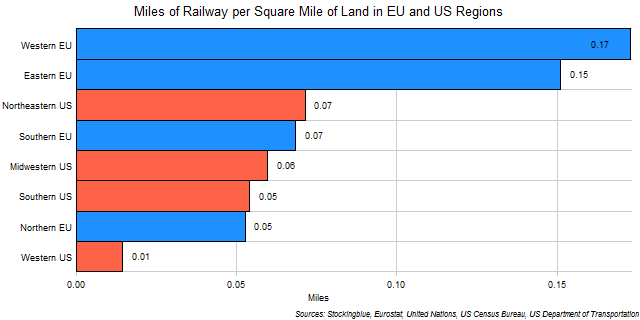
The chart above shows the miles of rail per square mile of land in EU and US regions. The Europeans have more rail per unit of land than we Americans do which is not surprising at all. What is surprising is that the EU's region with the least rail coverage rivals the US's region with the most rail coverage.
Findings
- The difference between the region with the greatest rail coverage, the Western EU, and the region with the least, the Western US, is 0.16 miles per square mile (0.10 km per square km).
- The Western EU has 12 times the rail coverage that the Western US has.
- The Southern EU has two states without any rail network and still manages to best half the regions.
- The Western US is the only other region with a state without a rail network.
Caveats
- EU rail length data is from 2016 except for Belgium (2009), Denmark (1998), Greece (2015), the Netherlands (2003), Austria (2007), and Poland (2015). US rail length data is from 2013.
- EU area data is from 2007. US area data is from 2010.
- Road and area data come from different sources.
- EU and US data come from different sources.
- Numbers in the chart are rounded to the nearest hundredth.
- Cyprus, Hawaii, and Malta have no rail networks.
- The Western EU consists of Germany, United Kingdom, France, Netherlands, Belgium, Austria, Ireland, and Luxembourg.
- The Eastern EU consists of Poland, Czech Republic, Romania, Hungary, Slovakia, Bulgaria, Croatia, Slovenia, Lithuania, Latvia, and Estonia.
- The Northeastern US consists of New York, Pennsylvania, New Jersey, Massachusetts, Maryland, Connecticut, New Hampshire, Delaware, Maine, Rhode Island, and Vermont.
- The Southern EU consists of Italy, Spain, Portugal, Greece, Cyprus, and Malta.
- The Midwestern US consists of Illinois, Ohio, Michigan, Indiana, Minnesota, Wisconsin, Missouri, Iowa, Kansas, Nebraska, North Dakota, and South Dakota.
- The Southern US consists of Texas, Florida, Georgia, North Carolina, Virginia, Tennessee, Louisiana, South Carolina, Alabama, Kentucky, Oklahoma, Arkansas, Mississippi, and West Virginia.
- The Northern EU consists of Sweden, Denmark, and Finland.
- The Western US consists of California, Washington, Colorado, Arizona, Oregon, Utah, Nevada, New Mexico, Hawaii, Idaho, Alaska, Montana, and Wyoming.
Details
The two leading EU regions (the Western and Eastern EU) have more than double the rail coverage of the leading US region (the Northeastern US) and seem to be in a class by themselves. The remaining EU regions have rail coverage to every US region save for the Western US which has around one-fifth the rail coverage of the next trailing region.
The number of miles of railway per square mile of land for the European Union as a whole is 0.12 (0.07 km per square km) which ranks it just below the Eastern EU and above the Northeastern US. The number of miles of railway per square mile of land for the United States as a whole is 0.04 (0.02 km per square km) which ranks it just below the Northern EU and well above the Western US.
Sources
Eurostat. 2018. "Eurostat - Data Explorer: Railway Transport - Length of Tracks." Accessed March 20, 2018. http://appsso.eurostat.ec.europa.eu/nui/submitViewTableAction.do.
United Nations. 2007. "United Nations Statistics Division - Environment Statistics." Accessed January 23, 2018. https://unstats.un.org/unsd/environment/totalarea.htm.
United States Census Bureau. "Annual Estimates of the Resident Population: April 1, 2010 to July 1, 2016." Accessed December 12, 2017. http://factfinder2.census.gov.
United States Department of Transportation. 2015. "State Transportation by the Numbers." Accessed March 21, 2018. https://www.bts.gov/sites/bts.dot.gov/files/legacy/_entire.pdf.